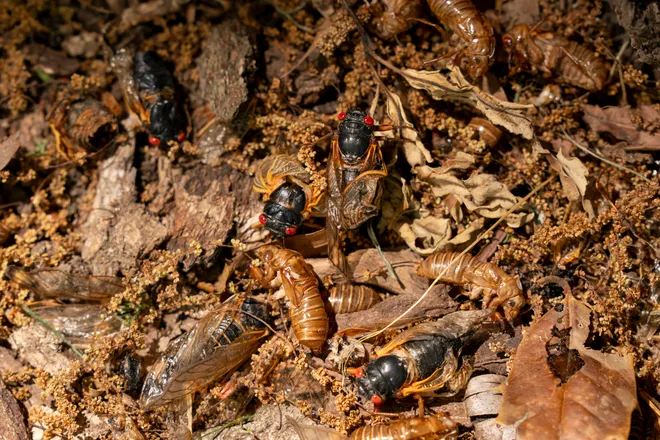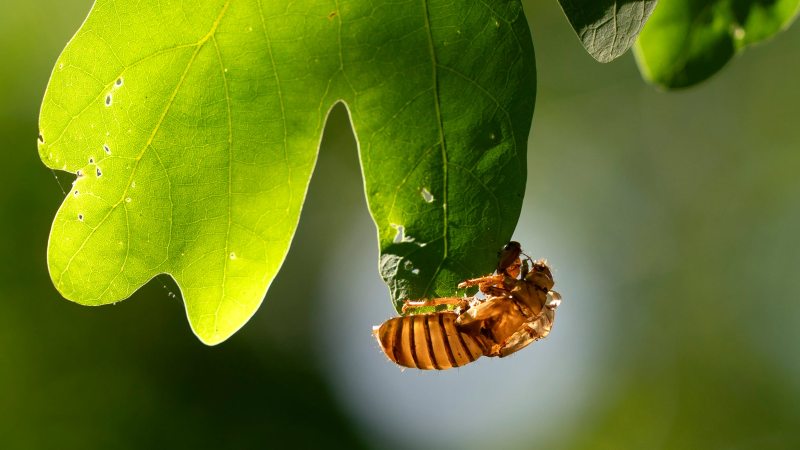Surprisingly, cicada broods keep going extinct. Some experts are working to save them.
The passenger pigeon once darkened the skies over the Midwest (they went extinct in 1914). A swarm of Rocky Mountain locusts once covered over 198,000 square miles (they went extinct in 1902).
Today several trillion periodical cicadas are emerging across 15 states in a rare double brood event, literally covering the ground in some places. They will all be dead by July. But their broods will live on — their offspring burrowing down into the dirt to grow until they emerge again, some in 2037 and some in 2041.
But that survival isn't a certainty. At least one brood has gone extinct in recent memory, and historically at least 12 American cicada broods have disappeared – warning signs that cicadas' massive numbers are surprisingly fragile.
In southern New England, Brood XI was last seen in 1954. Researchers at the University of Connecticut think it was likely due to the brood being at the very northern edge of where cicadas could successfully live. And across the Atlantic, researchers are on the hunt for signs Britain's only species of cicada is still alive.
It was last seen in the 1990s. An intensive search in 2013, including microphones dispersed throughout its habitat in the New Forest National Park, failed to find any living examples. Now the United Kingdom's Species Recovery Trust is beginning a project to potentially reintroduce the species from a still-living group in Slovenia.
“There’s a warning in this,” said Karim Vahed, manager for England for Buglife, also known as the United Kingdom's Invertebrate Conservation Trust. “The superabundance of a species doesn’t protect it from extinction.”

How could anything so numerous as cicadas disappear?
In some ways, the fact that periodical cicadas only come back every 13 or 17 years helps protect them. If trillions of cicadas hatched every year, however vital a part of the ecosystem they might be, it likely wouldn't have been enough to save them from the wrath of Americans denied their backyards and barbeques for weeks each summer.
Their very periodicity gives them cover. That’s not true of every bug.
“We’ve seen a major insect species go extinct,” said Vahed.
He's talking about the Rocky Mountain locust in the United States, which caused damage to farm crops as far back as the 1740s. In the 1870s, as settlers expanded into the Great Plains, these insects caused hundreds of millions of dollars of damage and devastated crops across multiple states. They even appeared in the popular children’s book “On the Banks of Plum Creek” by Laura Ingalls Wilder.

Then, mysteriously, they went extinct.
Researchers believe the locusts' delicate egg cases could not withstand plowing and the grazing of cattle and other animals as settlers worked their way West.
“That was the thing – it was so abundant that it was considered a major agricultural pest. But then plowing up its breeding areas was responsible for its demise,” Vahed said.
Never again did a swarm emerge as big as those of the 1870s. The last living Rocky Mountain locust was seen on the Canadian prairie in 1902.
In 2014 they were officially declared extinct by the International Union for the Conservation of Nature.
While overall periodical cicadas in the U.S. are doing well for now, they, too could be at risk for what many entomologists call "the insect apocalypse."
Periodical cicadas are subject to climate change, agricultural intensification, development, deforestation, and the introduction of exotic and invasive species – plus other issues caused more by their peculiar demographics, said John Cooley, a professor of ecology and evolutionary biology at the University of Connecticut who studies periodical cicadas.
“They are much like passenger pigeons – incredibly numerous, but subject to threshold dynamics – if the populations get below a certain density, or if they become too patchy, they likely go extinct quickly. Much of this is a concern as our eastern forests change in response to climate change,” he said.
Britain's cicada species on the brink
Across the Atlantic, naturalists have been hoping against hope that the British Isles’ only species of cicada has not gone the way of the Rocky Mountain locust.
Vahed's organization is part of a project that’s been searching, so far in vain, for any surviving Cicadetta montana cicadas in the New Forest National Park. No confirmed sightings have been made since the early 1990s, despite an intense effort beginning a decade ago.
That included a smartphone app that let park visitors “listen” for the insect’s high-frequency hissing call that can't be heard by most adults, though it can be heard by children.
Hundreds of recordings were turned in but none from the New Forest cicadas, which are slightly smaller than U.S. periodical cicadas and have black rather than red eyes.
The New Forest cicada was never superabundant but there are reports of it dating back to 1812. So little is known about the population that researchers aren't sure what its life cycle is or how often it should reappear – but as it hasn’t been seen in almost 30 years, hopes are dimming.
“It is possible the species is extinct in the United Kingdom,” Vahed said, though other populations of the cicada still survive in Europe.
Saved by William the Conqueror
The New Forest cicada is “a fussy one,” with very particular requirements for herbaceous vegetation for egg laying and mature trees for other parts of its lifecycle, said Ian Barker, an ecologist with the New Forest National Park.
It is (or was) already at the edge of its range in England and only survived because of the British royal passion for hunting.
The forest has been there since at least neolithic times, said Barker, but increased agriculture meant farmers cut down the thick deciduous forests to bring land under the plow.
“The key thing in its history is that after the Norman Conquest (in 1066) King William, known as William the Conqueror, designated it as a royal hunting forest, so cultivation was tightly controlled,” said Barker.
That saved the forest, and the New Forest cicadas, for a thousand years.
Today, climate change and land use are thought to have played a part in its demise. England has experienced wetter winters, “which don’t have a good effect on the underground cicada nymphs feeding on tree roots,” Vahed said.
There have also been changes in how the New Forest is managed, with less logging and grazing in some areas. Previously those activities had created open, warmer patches in the forest where the cicadas appeared to thrive. Now the forest is less open and has fewer open patches, Vahed said.
Despite the silence in the forest, Vahed and others haven’t entirely given up hope.
“There’s a potential that a generation of adults could have been missed and then could still be underground. So it’s going to take at least another decade before we’re convinced that they’ve gone extinct. But it’s not looking good.”
A Cicada Plan B
If the New Forest cicada has gone extinct, there is a Plan B – a never-before tried species translocation from a remote forest in Slovenia where the cicadas have a population to the low hills and plains of southern England.
The Species Recovery Trust hopes to reintroduce a population to a special enclosed cicada habitat at Paultons Park theme park, which contains a zoo and sits on the edge of the New Forest.
They won’t be visible for long. The insects will have enough time to get used to their new home and then hopefully mate and burrow down to suckle at the roots of hazel trees.
Then sometime in the next six to eight years, they will emerge to potentially begin a new chapter in the lives of cicadas in the British Isles – what the Trust calls conservation translocation.
Where exactly that will happen isn’t entirely clear. The Species Recovery Trust is still waiting to see if it can get permission for the reintroduction into the New Forest. If they don’t, they’ll keep them at the theme park.
Lead project officer Charlotte Carne hopes they’ll be allowed to do the reintroduction.
“For me, there’s also something about the fact that their calls haven’t been heard for decades,” she said in a statement. “I want my children to be able to walk through the forest in 10 or 20 years and hear them; to really experience the sounds of the New Forest.”
Disclaimer: The copyright of this article belongs to the original author. Reposting this article is solely for the purpose of information dissemination and does not constitute any investment advice. If there is any infringement, please contact us immediately. We will make corrections or deletions as necessary. Thank you.






